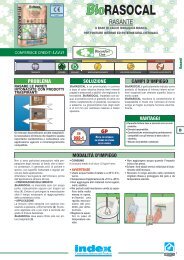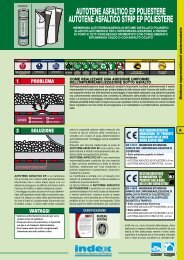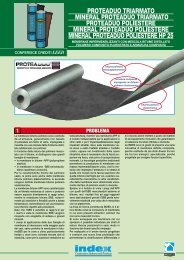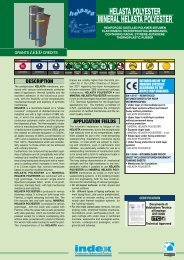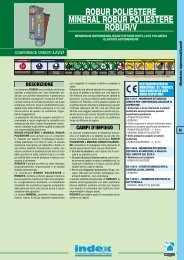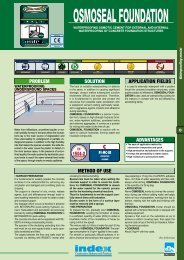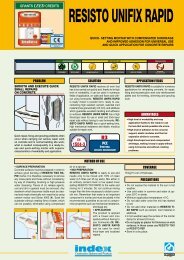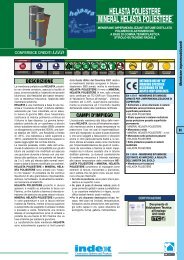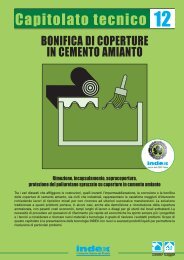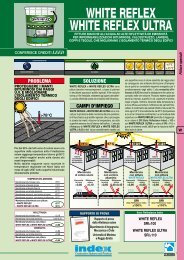ROOFS WITH PHOTOVOLTAIC SYSTEMS - Index S.p.A.
ROOFS WITH PHOTOVOLTAIC SYSTEMS - Index S.p.A.
ROOFS WITH PHOTOVOLTAIC SYSTEMS - Index S.p.A.
You also want an ePaper? Increase the reach of your titles
YUMPU automatically turns print PDFs into web optimized ePapers that Google loves.
REFLECTANCEBlack bituminous membrane 0.80EMISSIVITYBlack bituminous membrane >0.80Painted aluminium membrane 0.90The application of a WHITE REFLEX paint,which can maintain the temperature of thewaterproof covering at a value around 40°C,reduces the temperature of the rigid crystallinesilicon photovoltaic panel by 10 - 20°C, increasingits output by 3 - 8%. Photovoltaic paneloutput rises as the environmental luminosityincreases.The WHITE REFLEX reflective paint increasesalbedo, improving photovoltaic panel output.It is estimated that the combination of thesetwo effects increases the output of photovoltaicpanels with traditional concentration (consistingof crystalline or polycrystalline cells) by around4 - 10%.To demonstrate and prove this statement,WHITE REFLEXSolar Reflectance <strong>Index</strong>SRI>100In compliance with GreenBuilding Council criteria, theWHITE REFLEX paint used onthe slate membrane helps tosatisfy the following LEED criteria:member of GBC ItaliaLEED - EA Credit 1: OptimiseEnergy PerformanceCool roofs with WHITE REFLEX paint can bemodelled in the design proposal to demonstratethe impact in the reduction of free heat contributions.If the suggested roof has an initial reflectanceof at least 0.70 and an emissivity of atleast 0.75, the design proposal may use a modelledreflectance of 0.45, thus taking account ofits degradation, as opposed to the default valueof 0.30 modelled on the reference building.ROOF <strong>WITH</strong> WHITE REFLEXReflectance >0.80Emissivity >0.90LEED - SS Credit 7.2. Heat Island Effect - RoofsRoofs painted with WHITE REFLEX reduce the“heat island” effect (differences in heat gradientbetween urban areas and green spaces) andminimise impact on the surrounding microclimate,as well as human and animal habitats.Option 1: requires roofing materials with a SolarReflectance <strong>Index</strong> (SRI) equal to or greater thanthe values indicated in the table below for aminimum of 75% of the roof surface.Gently sloping pitchedroofs≤2:12(9.5°-16.7%)Steep pitchedroofs>2:12(9.5°-16.7%)Roof withWHITE REFLEXLEED standardSRI≥78LEED standardSRI≥78SRI≥100Option 3: Install high albedo and vegetated roofsurfaces that together meet the following criteria:(Area of roof meeting minimum SRI/0.75)+ (Area of vegetated roof/0.5) ≥ Total roof areaLEED - EA Credit 2: On-Site Renewable EnergyWHITE REFLEX increases the output of photovoltaicsolar panels, one of the systems usedin the on-site production of energy from renewablesources, permitted in point EA 2 andused to balance the energy consumption of thebuilding (the estimated rise is 4 - 10%, testsare currently being conducted on roof-installedsystems).INDEX has been conducting a series of on-sitetests and laboratory trials since 2007, in collaborationwith the University of Modena andReggio Emilia.In addition to waterproofing tests on the mostvaried application surfaces, specific examinationshave been conducted to assess potentialincreases in energy production which can be attributedto the presence of a reflective supporttreated with WHITE REFLEX.Since April (the month in which WHITE REFLEXwas applied), the energy production levels of aphotovoltaic system with crystalline silicon cellshave been monitored.This is located on a roof measuring approx. 700m 2 so that a comparison can be made betweenbefore and after the reflective cooling treatmentis applied using WHITE REFLEX paint.Technical specifications<strong>ROOFS</strong> <strong>WITH</strong> <strong>PHOTOVOLTAIC</strong> <strong>SYSTEMS</strong>5



